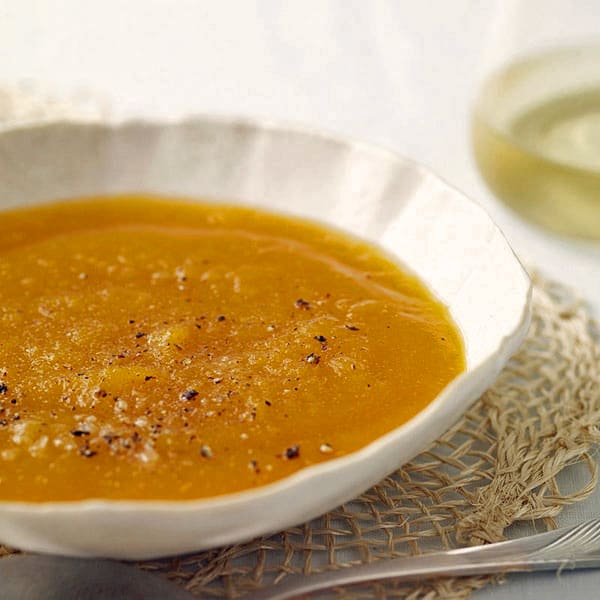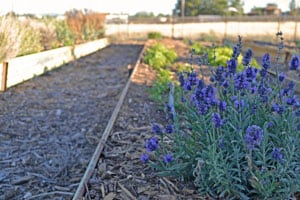We are sharing an article that we’ve written for magazine publication and has been in the October 2013 issue of Acres USA as well as the Fall 2013 edition of Small Farmer’s Journal. Compost is one of the foundational cornerstones of any successful garden, but has been over-thought and made much too complex by people wanting to make it “faster” or sell you some piece of equipment or machinery to make it “better”. It really is simple to make and doesn’t take any equipment, only needing time to accomplish. After all, who turns and works the compost in nature?
This is about our experiences and what we’ve learned from about 15 years of composting. Enjoy!
What We’ve Learned from Compost
Having been gardening for 15 years and composting for almost as long, we quickly realized that with our climate and native soils, improving the soil’s health and quality were one of the most important things we could do to help our garden. We are located in North-central Arizona, which is a semi-arid high grassland environment. Historically there would be 18 – 20 inches of moisture per year, but we have been lucky to see 10 – 12 inches in a good year over the past 20 years. There is almost always a south-westerly breeze which pulls moisture from any unprotected ground. The soils are really varied in structure with many different types in close proximity to each other. It is not uncommon to have a good productive soil with a caliche or high sandy soil within 20 – 50 feet. Our garden is a good sandy loam, with decomposed granite about 30 feet to the east and a heavy clay caliche soil 20 feet to the west.
 Good, aged compost has helped us build the health and fertility of our soil and overcome many of the challenges we face in our garden. It improves the soil structure, brings the micro nutrients and biological life to the soil, along with earthworms and larger soil dwellers. Mulching the compost helps to retain needed moisture and brings the soil moisture level from about 2 inches down to the surface of the soil/mulch interface. We use a combination of straw and wood chips for our mulch.
Good, aged compost has helped us build the health and fertility of our soil and overcome many of the challenges we face in our garden. It improves the soil structure, brings the micro nutrients and biological life to the soil, along with earthworms and larger soil dwellers. Mulching the compost helps to retain needed moisture and brings the soil moisture level from about 2 inches down to the surface of the soil/mulch interface. We use a combination of straw and wood chips for our mulch.
There is much we have learned that we have applied to our approach in creating great compost, along with observations and education we have sought out along the way. We are happy to share some of our experiences and knowledge about compost.
We don’t turn our compost, partly from being busy and not wanting to invest in machinery or equipment, also partly from research, reading and talking with those who have learned how to create some incredibly rich, earthy compost that looks like highly fertile soil. Most compost tumblers are too small for our needs and a tractor or turning equipment is an expensive purchase for the occasional use.
Our compost piles will age for at least a year before being added to the garden. We have learned that the slow aging is more beneficial to the decomposition process as well as not losing nearly as much nitrogen to off-gassing as happens with the hot and fast methods. Another benefit is the decomposition is much more thorough, destroying weed seeds, pathogens and any unwanted chemicals much better in a slower composting setup. In our climate, we need to water our compost occasionally to keep it going. This is easy to gauge, as the rich earthy smell goes away when the moisture level drops. We water about every 2 weeks on average during warmer weather.
(Cautionary note for those that use city water with chlorine in it: chlorinated water will kill the micro-organisms in the compost and soil that you are working to help! If you have chlorinated water, either fill buckets and let them sit overnight to off-gas the chlorine or buy a chlorine filter that attaches to the garden hose to remove it. Thanks to Marguerite from IL for pointing this out!)
 In our research and education of how to make great compost, we consistently saw traditional, proven methods from different countries, climates and approaches that worked. Many of them were very similar, adjusted to adapt to the particular environments of where they were used. The French intensive method used 3 feet of fresh horse manure and straw to heat the cold frames over the winter in Paris, then were pulled out and added to the compost piles to finish decomposing. In the fall the aged compost was added back to the growing beds for the upcoming winter. The Russian dacha gardening tradition shows how continuous composting and mulching with wood chips will improve the soil, overcoming both heavy winters in the north and drought conditions in the south.
In our research and education of how to make great compost, we consistently saw traditional, proven methods from different countries, climates and approaches that worked. Many of them were very similar, adjusted to adapt to the particular environments of where they were used. The French intensive method used 3 feet of fresh horse manure and straw to heat the cold frames over the winter in Paris, then were pulled out and added to the compost piles to finish decomposing. In the fall the aged compost was added back to the growing beds for the upcoming winter. The Russian dacha gardening tradition shows how continuous composting and mulching with wood chips will improve the soil, overcoming both heavy winters in the north and drought conditions in the south.
Another thing that we found is that European traditions and older American traditions applied compost thickly, about 3 – 4 inches at a minimum, while modern gardening applies it rather thinly – like expensive imported marmalade on toast – and then wonder why they don’t get the results they expect.
After the year of aging and decomposing, our compost looks and smells like rich dark soil. This is especially pleasing to see in comparison to our pale tan native soils! Once we apply it to the garden beds, we mulch it with several inches of straw, watered well to keep it in place. Recently we have begun experimenting with wood chips as mulch, with good results. The wood chips help retain and gain moisture better than the straw, with the added benefit of attracting earthworms faster. The wood chips act like a layer of permeable insulation, attracting the cooler and moist early morning air that sheds its water when it meets the warmer temperature of the soil. This moisture travels into the soil and is retained. It is surprising to see and feel how moist the soil is under 2 – 3 inches of wood chip mulch when there has been no rainfall or drip irrigation at all!
Our approach to making the best compost possible is to combine or “stack” techniques, similar to the bio-tech industry, but it is much more effective with no worries about future side-effects! We will walk you through the different techniques we use and why we use them.
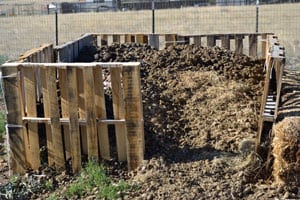 We have used straw bales as the container for our compost system for years, but have recently started using shipping pallets to more effectively utilize the composting area. The pallets are almost 3 times as tall as the straw bales and will give more compost in the same footprint. Wood chips are put down first, about 3 – 4 inches thick. These help retain moisture at the bottom of the pile before it seeps into the soil, as well as helping to attract earthworms and adding nutrients as they break down. We will scatter wood chips throughout the pile as we add horse manure. The nitrogen of the manure helps in the breakdown of the lignin in the wood chips, creating richer and more fertile compost.
We have used straw bales as the container for our compost system for years, but have recently started using shipping pallets to more effectively utilize the composting area. The pallets are almost 3 times as tall as the straw bales and will give more compost in the same footprint. Wood chips are put down first, about 3 – 4 inches thick. These help retain moisture at the bottom of the pile before it seeps into the soil, as well as helping to attract earthworms and adding nutrients as they break down. We will scatter wood chips throughout the pile as we add horse manure. The nitrogen of the manure helps in the breakdown of the lignin in the wood chips, creating richer and more fertile compost.
Our two horses provide the bulk of the manure, along with the occasional load of cow manure. We are careful to get our cow manure from non-feedlot sources to avoid any contamination from antibiotics, glyphosate or industrial chemicals. This has supplied enough finished compost for our 14 thirty foot long raised bed garden that is our home and trial garden for our heirloom seed business. We apply compost twice a year, mid fall and early spring.
Straw is used to mulch the top of the pile and provides aeration as more manure is added to the top. About 1 – 2 inches of straw is added across the top about every two feet of depth. This is continued as the pile grows in height. As the straw bales that make up other bins start to fall apart, they are added to the new piles.
Milk is diluted 50/50 and sprayed on the pile to help feed the microorganisms and jump starts the decomposition process. The amino acids, proteins, enzymes and natural sugars that make milk a food for humans and animals are the same ingredients in nurturing healthy communities of microbes, fungi and beneficials in compost and garden soil. Raw milk is the best, as it hasn’t been exposed to heat that alters the components in milk that provide a perfect food for the soil and plants, but any milk will work. Using milk on crops and soils is an ancient technique that has been lost to modern industrial agriculture.
Molasses adds readily available sugars to the compost that will skyrocket the microbial activity, with the addition of needed mineral content. We use one cup of molasses to a gallon of water and spray onto the pile once it is about 1 – 2 feet tall.
Coffee grounds are added routinely as the pile builds to help with moisture retention and buffer our alkaline soils. Traditionally, coffee grounds were seen as an acidic addition but recent research shows that coffee grounds act more as a buffer, moderating either an acidic or alkaline pH toward a more neutral one. In arid regions coffee grounds can be added up to 25% by volume of the pile. They are a good nitrogen source to help keep the decomposition going as well as being a natural earthworm attractant! Sourcing the coffee grounds comes from local coffee houses, restaurants, Starbucks, etc.
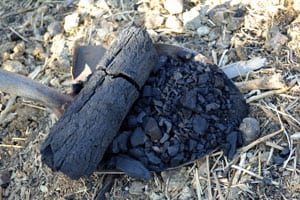 Hardwood lump charcoal or Bio-Char is added as the pile grows to help the compost in many ways. The most obvious benefit is to add carbon to the soil. Charcoal has a lifetime benefit of several hundred years, as shown by Brazilian university studies on the Amazonian “Terra Preta” sites in the rainforest. It must be hardwood lump charcoal and not briquettes, which are processed with chemical fire accelerators, sawdust and other industrial waste. We like to crush it to about the size of a grain of corn to increase its surface area and effectiveness.
Hardwood lump charcoal or Bio-Char is added as the pile grows to help the compost in many ways. The most obvious benefit is to add carbon to the soil. Charcoal has a lifetime benefit of several hundred years, as shown by Brazilian university studies on the Amazonian “Terra Preta” sites in the rainforest. It must be hardwood lump charcoal and not briquettes, which are processed with chemical fire accelerators, sawdust and other industrial waste. We like to crush it to about the size of a grain of corn to increase its surface area and effectiveness.
Charcoal acts like a sponge for the first 6 months or so, absorbing minerals and nutrients from the surrounding soil or compost while it “charges” or “activates”. After that it becomes an active beneficial component of the soil, providing housing and food sources for the microbial communities. Mycorrhizal Fungi will colonize charcoal and help to monitor the surrounding soil health, moving nutrients around as needed by plants. It was previously thought that mycorrhizae would only colonize the roots of plants, but it has been found that they will also inhabit charcoal. This will help them live throughout a winter when little root life or activity is present. The charcoal is sourced in 40 pound bags from buying clubs such as Costco or Sam’s Club, and can be obtained in larger quantities directly from the manufacturer.
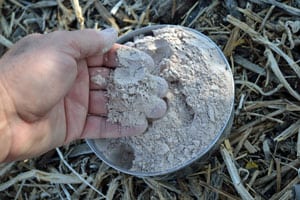 Trace minerals are added such as Azomite or Elemite to increase the available mineral and trace elements that are often low in today’s feed. This helps the decomposition of the pile, is absorbed in the charcoal and carries over to help feed the garden soil.
Trace minerals are added such as Azomite or Elemite to increase the available mineral and trace elements that are often low in today’s feed. This helps the decomposition of the pile, is absorbed in the charcoal and carries over to help feed the garden soil.
Once the compost pile is at the top of the bin, we cover it with a generous layer of straw and build a new bin. Then we pretty much ignore the active pile except for watering when it needs it. Every couple of months we check the pile to see how it is progressing, and see how much it has started to drop in height. Once the pile is finished it will have dropped about 1/4 to 1/3 of its original height.
This system has evolved over several years to the present one and has continually produced better and better compost. This approach may sound like a lot of work, but with the system set up there is very little additional work after cleaning the horse pens. We usually get a full wheelbarrow of fresh manure every other day, and we rotate the addition of minerals, charcoal and wood chips on top of the wheelbarrow load which is then dumped onto the pile, putting the additions underneath the load. Once we have about 2 feet above the last straw layer, we add a few inches of straw. The scent of the active pile is that of a handful of rich fertile earth, so we gauge when to water when we can’t “smell the earth” as we walk by. The additional time needed to add to the nutrients range from the time it takes to add a couple of shovelfuls of wood chips or a scoop of Elemite to the wheelbarrow, to a couple of minutes to crush a few handfuls of charcoal.
No matter what your scale, from backyard home gardener to small acreage, these concepts can be scaled up or down to suit your particular needs and animals. Look to your neighborhood or community for feedstock and supplies for the compost pile. Most horse owners will be happy to give away their excess manure, as most do not compost it and it becomes a waste management issue. Some farms will have excess straw or broken bales that are not useful for them but would be excellent feed for your compost pile.
Good composting – like much of good agriculture – takes a certain amount of patience and observation, letting Mother Nature work her miracles on her schedule. Think about how nature decomposes and composts leaf litter in the forest or grasses in the pasture, they aren’t “done” in 30 to 60 days! Once the cycle is established, you will always have some great compost becoming available for the next feeding of your garden soil.


